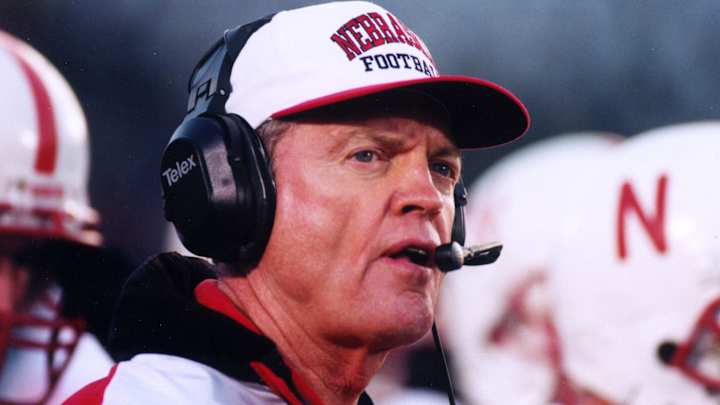Tale of the Coaching Tape: Nick Saban vs. Tom Osborne

Nick Saban will never, ever forget what it was like to face a Tom Osborne team. It was 1995, his first game as Michigan State’s head coach and Nebraska was the reigning national champion.
“They beat us 55-14, and the score did not indicate how bad they beat us,” Saban said. “I hadn't been in college football for four or five years, being in the NFL. I'm thinking we're never going to win a game. We'll never win a game here at Michigan State. I must have taken a bad job, wrong job, no players, something.
“I remember Coach Osborne when we shook hands after the game, he put his arm around me and whispered in my ear, ‘You're not really as bad as you think.’ So I think he knew he had a pretty good team, and we actually ended up winning six games, so we weren't really probably as bad as I thought.”
Actually, Nebraska was in the early stages of a dynasty, during which it won back-to-back consensus national championships, secured a split title in 1997, went 49-2, and had nine All-Americans. The Cornhuskers won two Outland Trophies, one Lombardi, and a Johnny Unitas Golden Arm trophy for best quarterback even though Nebraska wasn’t known for its passing.
Osborne too had a little bit of a rocky start after he replaced Bob Devaney in 1973, and developed a reputation for being unable to win big games after losing his first five, and seven of eight against rival Oklahoma. Once he cleared that hurdle, though, and finally played for the national championship at the end of the 1983 season, the coach came up short after making one of the gutsiest calls in college football history.
After a fierce comeback in the Orange Bowl against hometown No. 4 Miami, top-ranked Nebraska scored on Jeff Smith’s fourth-down 24-yard run with 48 seconds remaining. With No. 2 Texas, the only other undefeated team, having already lost earlier in the day to Georgia in the Cotton Bowl, a tie probably would have locked up the national title (there was no overtime), but Osborne went for the two-point conversion and the win only to see Turner Gill’s pass knocked down.
"We wanted an undefeated season and a clear-cut championship," Osborne said after the 31-30 loss that led to Miami finishing No. 1, ahead of Nebraska. "I don't think we should go for the tie in that case. It never entered my head. I guess I'm not very smart."
Instead, after Byron Bennett’s 45-yard field-goal attempt went wide left in the final seconds of the Orange Bowl, an 18-16 loss to Florida State to decide the 1993 title, Osborne had to wait until 1994 to win his first consensus national championship – although it was anything from simple, or easy, despite Nebraska’s 13-0 record.
Quarterback Tommie Frazier was sidelined after the fourth game by blood clot problems in his right knee, and a partially collapsed lung slowed replacement Brook Berringer. He still managed to lead a 24-17 victory against Miami at the Orange Bowl, and voters rewarded the Cornhuskers despite Penn State also finishing unbeaten at 12-0.
With Frazier able to return, Berringer went back to the bench in 1995 when Nebraska was able to defend its title and no opponent could come within 14 points of the Cornhuskers. Tragically, Berringer died the following spring in a plane crash.
“The Brook I knew, there was nothing he could have done better,” Osborne said. “The length (of his life) was not what you would have liked. But the quality couldn’t have been better.”
The split title came after a 42-17 victory against No. 3 Tennessee in the Orange Bowl, Osborne’s final game, when the coaches’ poll leapfrogged Nebraska over Michigan. Osborne called the squad “probably a little more talented than ’94, certainly not near as controversial as ’95. That was nice. So it was just kind of a nice way to go.
“Great leadership on the part of the players, and I didn’t have to do much.”
In the 1990s, Nebraska lost just three home games. While few programs have won 100 games in a decade, Nebraska is the only one in NCAA history to do it in consecutive decades.
Overall, Osborne had an incredible 255-49-3 record from 1973-97, when the Cornhuskers recorded 15 10-win seasons. Their worst showing was 9-3-1 in 1976, with a trip to the Bluebonnet Bowl – a 27-24 victory against Texas Tech. Between Devaney and Osborne, who in 2000 won a seat in the U.S. House of Representatives and served for six years, Nebraska appeared in a record 35 consecutive bowl games (1969-2003), including 17 straight January bowl appearances (1981-97).
Consequently, all 25 of Osborne’s teams received a bowl invitation, and finished ranked in the final Associated Press poll.
However, to give an idea of how times have changed in college football, over his whole career Osborne was involved in just three No. 1 vs. 2 games, going 1-2. When Alabama defeated Notre Dame for the 2012 national title it was Saban’s fifth over the previous 49 months.
Ohio State beats Michigan State 48-3
— Pick Six Previews (@PickSixPreviews) November 11, 2017
Michigan State's worst regular season loss since Tom Osborne's Nebraska beat Nick Saban 50-10 (1995) pic.twitter.com/RswB4L56yo
Nick Saban vs. Tom Osborne
(Statistics through 2018 season for continuity purposes)
Category, Saban; Osborne
Seasons 23 ; 25
Consensus national titles 6 ; 2-z
Top five finishes 9 ; 8
Top 25 finishes 16 ; 25
Overall record 232–62–1; 255-49-3
Percentage 78.5 ; 83.6
Losing seasons 0 ; 0
CFP/Bowl record 14-10 ; 12-13
Percentage 58.3 ; 48.0
Conference titles 9 ; 13
Conference record 138-42-1; 160-23-2
Consensus All-Americans 41 ; 30
First-round draft picks 34 ; 19
Record against ranked teams 82-40 ; 62-37-1
Percentage 67.20 ; 62.50
Record against top 10 teams 42-21 ; 27-32
Percentage 66.67 ; 45.76
Ratios/percentages
National title seasons One every 3.8 seasons; 12.5
Consensus All-Americans 1.78 every season; 1.2
First round draft picks 1.48 every season; .76
Average wins vs. ranked teams 3.57 each season; 2.48
Wins over top-10 teams per year 1.82 every season; 1.08
z-Nebraska split the national championship with Michigan in 1997.
Some of the information in this report was also used in the book "Nick Saban vs. College Football."
